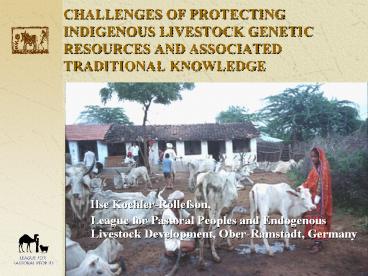CHALLENGES OF PROTECTING INDIGENOUS LIVESTOCK GENETIC RESOURCES AND ASSOCIATED TRADITIONAL KNOWLEDGE - PowerPoint PPT Presentation
1 / 17
Title:
CHALLENGES OF PROTECTING INDIGENOUS LIVESTOCK GENETIC RESOURCES AND ASSOCIATED TRADITIONAL KNOWLEDGE
Description:
Title: Exchange, access and benefit-sharing of animal genetic resources Author: Paul Mundy Last modified by: kpramesha Created Date: 6/28/2005 8:34:03 AM – PowerPoint PPT presentation
Number of Views:158
Avg rating:3.0/5.0
Title: CHALLENGES OF PROTECTING INDIGENOUS LIVESTOCK GENETIC RESOURCES AND ASSOCIATED TRADITIONAL KNOWLEDGE
1
CHALLENGES OF PROTECTING INDIGENOUS LIVESTOCK
GENETIC RESOURCES AND ASSOCIATED TRADITIONAL
KNOWLEDGE
- Ilse Koehler-Rollefson,
- League for Pastoral Peoples and Endogenous
Livestock Development, Ober-Ramstadt, Germany
2
Domestic Animal Diversity
- The vast majority of breeds has been created by
pastoralists and farmers - Small-scale LK and pastoralists conserve
in-situ - Guardians of livestock biodiversity
3
Highly evolved breeding strategies
- Conserve and consolidate specific gene pools
(breeds) - Ensure diversity within herds
- Require people-centered, anthropological
methods to be detected - Have therefore remained largely invisible
4
Elements of IK-AB
Breeding decisions
Cultural identity and rules
Breeding management
Cognitive processes
Social mechanisms
5
Cultural identity and stewardship
- Identity of some traditional cultures based on
relationship with animals - Feeling of responsibility for welfare of animals
- Especially pastoralists
- Examples
- Raika - camel ( cattle)
- Fulani, Maasai - cattle
- Tzotzil Indian - sheep
6
Social breeding mechanisms
- Socially embedded customs influencing the gene
pool - Taboos on selling female animals outside
community - Rules for passing on animals from one generation
to next - Sharing mechanisms
7
Selection criteriabeyond productivity
- Ability to put on fat
- Good maternal behaviour
- Walking ability
- Drought resistance
- Love of owner
- Manageability
8
Nauguna 9 criteria used by Raika sheep
breeders
- Wool production
- Milk production
- Good pedigree, true to breed
- Mothering abilities
- Height
- Good walker
- Fast growth rate
- Drought and famine resistant
- Beauty
- High birth weight
- Ability to endure and withstand pain
9
Contrast between indigenous and scientific animal
breeding
- Indigenous breeding considers a variety of
criteria - Scientific breeding focuses on a limited number
or even a single production trait? high
performance breeds
10
Livestock and poultry breeds, globally
- 6,379 livestock and poultry breeds
Extinct 740 breeds
Critical or endangered 1694 breeds
Other 3945 breeds
Source FAO
11
Paradigm shift Renewed interest in indigenous
livestock breeds
- Local breeds more productive under low levels of
inputs - Most suitable foundation for livestock
development in marginal environments - Indigenous breeds have disease-resistance traits
? interest to the livestock industries and
scientists
12
The Advance of Genomics
- Research on livestock genetics has shifted to the
molecular level. - Genomes of four species (cattle, chicken, pig,
sheep) have been completely or largely
deciphered. - Initially carried out with public funds in
government institutions - Now regarded as major business opportunity
- Animal industry is estimated to be worth 100
billion in US, and 240 billion globally.
13
Mapping of Genomes
- is expected by some to create a 5-10 efficiency
improvement in the food business - achieved
through improved feed conversion rates, faster
growth rates, and higher retail yield - Seen as a 5-10 billion dollar business
opportunity for biotech companies.
14
Intellectual Property Rights (IPR)
- In genomics research, intellectual property
rights are exercised as a matter of course and
patents applied for immediately. - Latest example Monsantos application in over
160 countries for a series of patents on
pig-breeding.
15
History of Livestock Keepers Rights
- First mention at World Food Summit in 2002, in
allusion to Farmers Rights in International
Treaty on Plant Genetic Resources - Clarified in further meetings
- Karen Commitment - 2003
- Bellagio Brief - 2006
- Regional Pastoralists Gathering in Yabello,
Ethiopia - 2006 - LIFE-Network Meeting in Sadri (Raj./India) - 2007
16
LKR Bundle of Rights
- 1 Recognition of livestock keepers as creators
of breeds and custodians of AnGRFA - 2 Recognition of the dependency of the
sustainable use of traditional breeds on the
conservation of their respective eco-systems - 3 Recognition of traditional breeds as
collective property, products of indigenous
knowledge and cultural expression. - 4The right of the livestock keepers to make
breeding decisions - 5 Right of livestock keepers to participate in
policy making processes on AnGRFA issues - 6 Support for training and capacity-building of
livestock keepers and provision of services along
the food chain.
17
National-International LIFE-Network
Workshop24-26 February, 2007
- Pastoralists hand over statement to Indias
Director of AnGR































